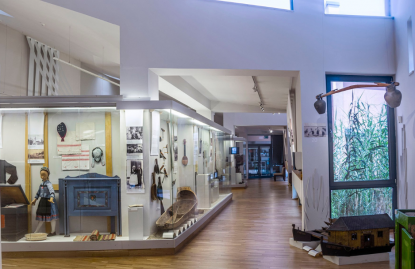2024. May 9. Thursday
Kanizsan Dorottya Museum - Mohács

|
Address: 7700, Mohács Kisfaludy u. 9.
Phone number: (69) 306-604
E-mail: kdm@jpm.hu
Opening hours: Tue-Sat 10-16
|
The Museum of Mohács was founded in 1925. It took on the name of Dorottya Kanizsai in 1953. In 1975 it received the status of the basic museum of the Croatians, Serbians, and Slovenians living in Hungary, thus it has the tether of the parliament.
It has a collection of 12 000 pieces of ethnological pieces and 5 000 pieces of local history. Besides these, they have a photo collection of about 25 000 pieces. The sound material makes up about 20 000 minutes.
The very rich ethnographic collection is a rarity in Hungary. All the areas where Serbians, Croatians, or Slovenians live are represented. The number of the objects in connection with an ethnic groups truthfully mirror their proportion compared to the population of the country. According to this most of the objects displayed are in connection with the Croatians.
The biggest groups of the collection include textile, folk dresses, and other textile of folk art. These are displayed separately according to the region they are from.
The Croatian ethnic groups living in Hungary are the followings: Bosnians, Catholic Serbians, Sokac population, Croatians from the Drava region, Croatian from the Mura region, Western Croatians, and Serbians. There are smaller groups in these larger groups.
Besides the rich Croatian folk dress collection the Serbian textile material, mainly the white embroidery and the woven material is significant.
The painted chests, beds, wall bricks, and the benches represent the furniture collection. The ornamentation of the wrought chests commodes and clearly show the changes in vernacular art. Their colors and the motifs used are significant of the given ethnic group.
Our collection of ceramics is also important. Besides the black and enameled ceramics of Mohács, ceramics from other regions are shown as well. The oldest piece of the black ceramics is from 1791. Among the enameled ceramics the richest is the dish collection. It is made of different shaped and colored plates, bowls, and jugs. There are works by old masters and men practicing nowadays. Looking at the works of Mátyás Kulutácz, János Horvát, and László Horvát the visitors may see artistic features beside their keeping the old traditional forms.
Some trades display a whole set of their tools: some of the fishing equipments, tailor tools, and the tools and equipment of smith shops, photo shops, honey cake makers etc.
The 40 masks represent the most widely known tradition of Mohács, the Busó celebration. Sometimes these masks are displayed in other museums of other towns as well.
It has a collection of 12 000 pieces of ethnological pieces and 5 000 pieces of local history. Besides these, they have a photo collection of about 25 000 pieces. The sound material makes up about 20 000 minutes.
The very rich ethnographic collection is a rarity in Hungary. All the areas where Serbians, Croatians, or Slovenians live are represented. The number of the objects in connection with an ethnic groups truthfully mirror their proportion compared to the population of the country. According to this most of the objects displayed are in connection with the Croatians.
The biggest groups of the collection include textile, folk dresses, and other textile of folk art. These are displayed separately according to the region they are from.
The Croatian ethnic groups living in Hungary are the followings: Bosnians, Catholic Serbians, Sokac population, Croatians from the Drava region, Croatian from the Mura region, Western Croatians, and Serbians. There are smaller groups in these larger groups.
Besides the rich Croatian folk dress collection the Serbian textile material, mainly the white embroidery and the woven material is significant.
The painted chests, beds, wall bricks, and the benches represent the furniture collection. The ornamentation of the wrought chests commodes and clearly show the changes in vernacular art. Their colors and the motifs used are significant of the given ethnic group.
Our collection of ceramics is also important. Besides the black and enameled ceramics of Mohács, ceramics from other regions are shown as well. The oldest piece of the black ceramics is from 1791. Among the enameled ceramics the richest is the dish collection. It is made of different shaped and colored plates, bowls, and jugs. There are works by old masters and men practicing nowadays. Looking at the works of Mátyás Kulutácz, János Horvát, and László Horvát the visitors may see artistic features beside their keeping the old traditional forms.
Some trades display a whole set of their tools: some of the fishing equipments, tailor tools, and the tools and equipment of smith shops, photo shops, honey cake makers etc.
The 40 masks represent the most widely known tradition of Mohács, the Busó celebration. Sometimes these masks are displayed in other museums of other towns as well.
